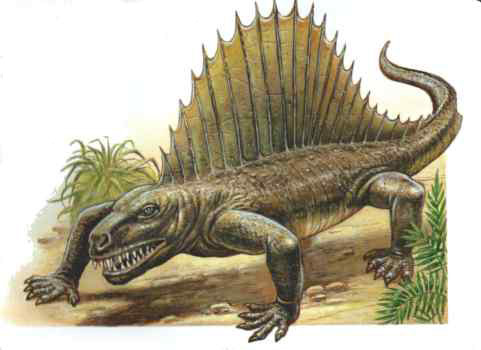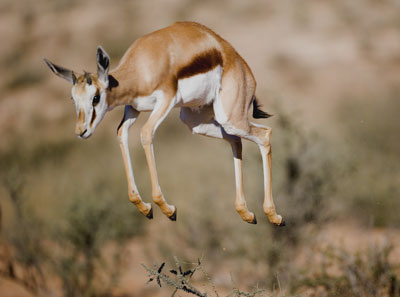Crocodiles have been around since dinosaur times, and prehistoric versions are always popping up. It is interesting how the basic crocodile design hasn’t changed much over the millions of years, showing it is very efficient. Therefore, as a mad scientist you should look to efficient nature models when designing superwarrior monsters of your own. And keep these crocodylomorphs in mind for fun variations from a common theme. Just keep in mind any crocodile monsters I create will be far superior.

Scientists Unveil Prehistoric “Sea Warrior” Crocodile
A fossil of a new prehistoric crocodile species “Guarinisuchus munizi” is seen during a press conference at National Museum of the Rio de Janeiro Federal University in Rio de Janeiro, Wednesday, March 26, 2008. Brazilian scientists say they have found a new prehistoric crocodile species that inhabited the Earth’s oceans some 62 million years ago.
(Ricardo Moraes/AP Photo)
Pointy-nosed crocodiles may have joined sharks as the dominant predators in the world’s oceans some 62 million years ago, according to Brazilian scientists who on Wednesday unveiled one of the most complete skeletons found yet of the prehistoric animals.
Scientists called it a new species, “Guarinisuchus munizi,” and said it sheds new light on the evolutionary history of modern crocodiles.
The fossil includes a skull, jaw bone and vertebrae, making it one of the most complete examples of marine crocodylomorphs collected so far in South America, said Alexander Kellner of the National Museum of the Federal University of Rio de Janeiro. He and other scientists unveiled fossils and a model of the 10-foot-long crocodile at the museum.
“It’s a very rare find and it gives rise to several new theories,” said Kellner, who co-authored an article on the find that was published Tuesday in Proceedings of The Royal Society B, a London-based peer-reviewed journal.
Guarinisuchus appears to be closely related to marine crocodylomorphs found in Africa, which supports the hypothesis that the group originated in Africa and migrated to South America before spreading into the waters off the North American coast, Kellner said.
The find also suggests that marine crocodylomorphs replaced marine lizards during the early Paleocene era, about 65 million years ago — the same time marine lizards became extinct. They believe it’s a new species based on anatomical differences in the skull that are unique to this creature.
Philip Currie, a paleontology professor at the University of Alberta, Canada who was not involved with the discovery, said it was an important find.
“There are a lot of unknowns with this group in terms of evolution. Clearly the discovery of a specimen as nice as this one will help sort things out,” Currie said in telephone interview.
The bones were found in the northeastern state of Pernambuco. Scientists named the species “Guarinisuchus” after the Tupi Indian word “Guarani,” which means warrior and “munizi,” in honor of Brazilian paleontologist Deraldo da Costa Barros Muniz, who has discovered many dinosaur fossils off Brazil’s northeastern coast. Muniz didn’t participate in this find.
Scientists have discovered a wealth of crocodile ancestors around Brazil in recent years.
In January, they announced the discovery of an 80 million-year-old land-bound reptile described as a possible link between prehistoric and modern-day crocodiles.
Two years ago, paleontologists from the Federal University of Rio de Janeiro announced the discovery of a 70-million-year-old crocodile fossil that they called Uberabasuchus Terrificus, or “Terrible Crocodile of Uberaba.”
This “Terrible Crocodile of Uberaba” sounds interesting, so let’s dig up that story:

‘Terrible crocodile of Uberaba’ unveiled
Fossil offers look at Earth’s ecosystem of 70 million years ago
Thursday, February 17, 2005 Posted: 2109 GMT (0509 HKT)
RIO DE JANEIRO, Brazil (AP) — The discovery of a nearly intact fossil of a prehistoric crocodile is
teaching scientists what the world was like before the continents were separated by oceans, a Brazilian paleontologist said.
A reproduction of the previously unknown creature — dubbed Uberabasuchus terrificus, or the terrible crocodile of Uberaba, was unveiled Wednesday at the Federal University of Rio de Janeiro.
Uberabasuchus lived 70 million years ago and was smaller than today’s crocodiles — only about three meters (10 feet) long and weighing about 300 kilograms (650 pounds), said paleontologist Ismar de Souza Carvalho.
“It’s important because the fossil was extremely well preserved, with 85 percent of its skeleton practically complete and intact,” he said.
Carvalho said Uberabasuchus lived on land — it was named because the fossil was found near Uberaba, an inland city in southeastern Brazil. It probably carried its body high off the ground on sturdy legs and was a strong and voracious hunter, he said.
“We’re learning about a new species of crocodile, the ecosystem of 70 million years ago, and the evolution of the land crocodile on the ancient continent of Gondwana,” Carvalho said.
Scientists believe the continents then were joined in a huge land mass, which some call Gondwana. Fossils similar to Uberabasuchus have been found in Africa and in Antarctica, which possibly were linked to South America.
Despite some similarities with modern-day crocodiles, Uberabasuchus became extinct when the other great dinosaurs died out, and it has no relation to today’s crocodiles, Carvalho said.
Brazil has drawn international attention for its recent discoveries of prehistoric creatures.
In December, scientists unveiled a replica of Unaysaurus tolentinoi, an ancestor of the huge Brontosaurus, that lived 230 million years ago in what is now southern Brazil. Experts said it was more closely related to fossils found in Germany than to dinosaurs from neighboring Argentina.
Zootaxa, a scientific journal published in New Zealand, said Unaysaurus “differs from all other dinosaurs.”
Carvalho predicted there was more to come.
“Important new discoveries are practically certain,” he said.







